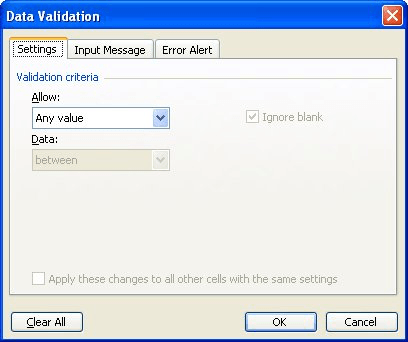Please Note: This article is written for users of the following Microsoft Excel versions: 97, 2000, 2002, and 2003. If you are using a later version (Excel 2007 or later), this tip may not work for you. For a version of this tip written specifically for later versions of Excel, click here: Single-Use Drop-Down List.
Written by Allen Wyatt (last updated February 3, 2024)
This tip applies to Excel 97, 2000, 2002, and 2003
One of the really cool uses for the data validation feature in Excel is the ability to create a single-use drop-down list. This list allows users to select the cell and then select from a list of pre-defined values for that cell. Once the user makes a selection and moves to a different cell, the arrow for the drop-down list disappears.
Start by creating a list of the values that you want available in the drop-down list. You can create this list almost anywhere, but for design purposes it is a good idea to put the list on a different worksheet than the one where the data entry will be.
For example, let's say that you want a list of employee names. On a new worksheet, enter the employee names in any manner desired. (You probably will want to sort them in some manner.) Select the list and give it a name such as Employees. (To define a name use Insert | Name | Define.) Now, back on the main worksheet, follow these steps:

Figure 1. The Data Validation dialog box.
Now, whenever someone selects the cell you used in step 1, they'll see a drop-down list arrow to the right of the cell. Clicking on the list provides a drop-down listing all the employees. The user can select one of the employees, but cannot enter a different name. When they move to a different cell, the drop-down list disappears, but the selected value remains visible.
As a side note, if you don't want to place your data list in a worksheet, then you can enter the choices directly into the Data Validation dialog box. In step 5 (the Source box), leave out the equal sign and just enter the choices. Separate them by commas, and those are the choices that will be available to the user.
ExcelTips is your source for cost-effective Microsoft Excel training. This tip (3182) applies to Microsoft Excel 97, 2000, 2002, and 2003. You can find a version of this tip for the ribbon interface of Excel (Excel 2007 and later) here: Single-Use Drop-Down List.

Program Successfully in Excel! John Walkenbach's name is synonymous with excellence in deciphering complex technical topics. With this comprehensive guide, "Mr. Spreadsheet" shows how to maximize your Excel experience using professional spreadsheet application development tips from his own personal bookshelf. Check out Excel 2013 Power Programming with VBA today!
The data validation capabilities of Excel allow you to easily create drop-down lists showing what data is acceptable for ...
Discover MoreWant to have a small help screen pop up when a user selects a particular cell? This can be done by using data validation, ...
Discover MoreData Validation is a great way to limit what a user can enter into a worksheet cell. It may not stop a cell from being ...
Discover MoreFREE SERVICE: Get tips like this every week in ExcelTips, a free productivity newsletter. Enter your address and click "Subscribe."
There are currently no comments for this tip. (Be the first to leave your comment—just use the simple form above!)
Got a version of Excel that uses the menu interface (Excel 97, Excel 2000, Excel 2002, or Excel 2003)? This site is for you! If you use a later version of Excel, visit our ExcelTips site focusing on the ribbon interface.
FREE SERVICE: Get tips like this every week in ExcelTips, a free productivity newsletter. Enter your address and click "Subscribe."
Copyright © 2024 Sharon Parq Associates, Inc.
Comments